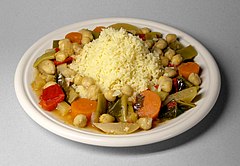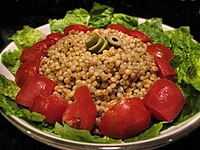Couscous
From Wikipedia, the free encyclopedia
| Serving Size 1 cup prepared (173 g) | |||
| Servings Per Container Information is per dry couscous as determined by Nutrient Data Laboratory, ARS, USDA.[1] | |||
| Amount Per Serving | |||
| Calories 650 | Calories from Fat 9 | ||
| % Daily Value* | |||
| Total Fat 1 g | 2% | ||
| Saturated Fat 0 g | 0% | ||
| Trans Fat 0 g | |||
| Cholesterol 0 mg | 0% | ||
| Sodium 17 mg | 1% | ||
| Potassium 287 mg | 8% | ||
| Total Carbohydrate 134 g | 45% | ||
| Dietary Fiber 9 g | 4% | ||
| Sugars 0 g | |||
| Protein 22 g | |||
| Vitamin A | 0% | Vitamin C | 0% |
| Calcium | 42% | Iron | 2% |
| *Percent Daily Values are based on a 2,000 calorie diet. Your Daily Values may be higher or lower depending on your calorie needs. | |||
Couscous or kuskus as it is known in Morocco, Algeria, Tunisia, Libya and Egypt (pronounced /ˈkuːskuːs/ in the US, /ˈkʊskʊs/ in the UK; Berber Seksu - Arabic: كسكس, called maftoul in Lebanon and the Palestinian territories) is a Berber dish consisting of spherical granules made by rolling and shaping moistened semolina wheat and then coating them with finely ground wheat flour. The finished grains are about 1 mm in diameter before cooking. The Levantine variant, popular also in Israel, is about twice the diameter and made of hard wheat instead of semolina.[2] Traditional couscous requires considerable preparation time and is usually steamed. In many places, a more processed quick-cook couscous is available and is particularly valued for its short preparation time.
The dish is a primary staple throughout the Maghreb;[3] in much of Morocco, Algeria, Tunisia, and Libya it is also known as ṭa`aam طعام, "food".[citation needed] It is also popular in the West African Sahel, in France, Madeira island, in western Sicily's Trapani province, and parts of the Middle East. It is particularly popular among Jews of North African descent, such as the Berber Jews,[4] and is eaten in many other parts of the world as well.
Couscous is traditionally served under a meat or vegetable stew. It can also be eaten alone flavoured or plain, warm or cold, as a dessert or a side dish.
Contents |
[edit] Manufacturing
The couscous granules are made from semolina (coarsely ground durum wheat) or, in some regions, from coarsely ground barley or pearl millet. In Brazil, the traditional couscous is made from pre-cooked sweetcorn flakes.[5]
[edit] Couscous from semolina (wheat)
The semolina is sprinkled with water and rolled with the hands to form small pellets, sprinkled with dry flour to keep the pellets separate, and then sieved. The pellets which are too small to be finished grains of couscous fall through the sieve to be again sprinkled with dry semolina and rolled into pellets. This process continues until all the semolina has been formed into tiny grains of couscous. Sometimes salt is added to the semolina and water.
This process is very labour intensive. In the traditional method of preparing couscous, groups of women would come together and make large batches over several days.[6] These would then be dried in the sun and used for several months. Couscous was traditionally made from the hard part of the hard wheat Triticum durum, the part of the grain that resisted the grinding of the relatively primitive millstone. In modern times, couscous production is largely mechanized, and the product sold in markets around the world.
[edit] Couscous from pearl millet
In the Sahel, pearl millet is pounded or milled to the size and consistency necessary for the couscous.
[edit] Background
[edit] History
One of the first written references is from an anonymous 13th century Hispano-Muslim cookery book, Kitāb al-tabǐkh fǐ al-Maghrib wa'l-Andalus (Arabic) "The book of cooking in the Maghreb and Al Andalus", with a recipe for couscous that was 'known all over the world'. Couscous was known to the Nasrid royalty in Granada as well. And in the 13th century a Syrian historian from Aleppo includes four references for couscous. These early mentions show that couscous spread rapidly, but that in the main, couscous was common from Tripolitania to the west, while from Cyrenaica to the east the main cuisine was Egyptian, with couscous as an occasional dish. Today, in Egypt and the Middle East, couscous is known, but in Morocco, Algeria, Tunisia, and Western Libya couscous is a staple. Couscous was taken from Syria to Turkey in 16th century and is eaten in most of southern provinces.
One of the earliest references to couscous in Northern Europe is in Brittany, in a letter dated Jan. 12 1699. But it made an earlier appearance in Provence, where the traveler Jean Jacques Bouchard writes of eating it in Toulon in 1630.
[edit] Cooking
Properly cooked couscous should be light and fluffy, not gummy or gritty; steam couscous two to three times to achieve this consistency.[citation needed] Traditionally, North Africans use a steamer called a kiskas in Arabic or couscoussière in French. The base is a tall metal pot shaped rather like an oil jar in which the meat and vegetables are cooked in a stew. On top of the base a steamer sits where the couscous is cooked, absorbing the flavours from the stew. The lid to the steamer has holes around its edge so that steam can escape. It is also possible to use a pot with a steamer insert. If the holes are too big the steamer can be lined with damp cheesecloth. There is little archaeological evidence of early diets including couscous, possibly because the original couscoussière was probably made from organic materials which could not survive extended exposure to the elements.
[edit] Instant couscous
The couscous available to buy in most Western supermarkets has been pre-steamed and dried, the package directions usually instruct to add a small amount of boiling water or stock to the couscous, cover tightly for 5 minutes. The couscous swells and within a few minutes is ready to fluff with a fork and serve. Pre-steamed couscous takes less time to prepare than regular couscous, most dried pasta, or dried grains such as rice.
[edit] Recipes and combinations
In Algeria, Tunisia, couscous is generally served with vegetables (carrots, turnips, etc.) cooked in a spicy or mild broth or stew, and some meat (generally, chicken, lamb or mutton); in Algeria, couscous can also be topped with fish in a sweet sauce with raisins and caramelized onions.
In Algeria it is also served, sometimes at the end of a meal or just by itself, as a delicacy called "Seffa". The couscous is usually steamed several times until it is very fluffy and pale in color. It is then sprinkled with almonds, cinnamon and sugar. Traditionally, this dessert will be served with milk perfumed with orange blossom water, or it can be served plain with buttermilk in a bowl as a cold light soup for supper.
Couscous is very popular in France where it's now considered a traditional dish. Indeed many polls have indicated that it is often a favorite dish. Although introduced in France by the pieds noirs (people of European descent who used to live in Algeria), many couscous restaurants are now owned by people originating from Algeria. In France the word "couscous" usually refers to couscous together with the stew. Packaged sets containing a box of quick-preparation couscous and a can of vegetables and, generally, meat are sold in French grocery stores and supermarkets. In France it is generally served with Harissa sauce.
In North America and Great Britain couscous is available most commonly as either plain or pre-flavoured, quick-preparation boxes. In the United States it is widely available but largely confined to the ethnic or health food section of larger grocery stores.
There are recipes from Brazil that use boiled couscous molded into timbale with other ingredients.
Taboule, a salad of Levantine origins is, today, more often made with the easier, quicker, couscous. The traditional recipe used crushed wheat, olive oil, chopped tomatoes, onion, parsley, mint, salt and pepper, mixed together and, where possible, chilled. It is often served as a side dish, great for buffets. Prepacked Taboule, in various combinations, is sold in shops, especially in France where the Maghreb influence is strong.
[edit] Similar products
- The name couscous is also used for prepared dishes made from other grains, such as barley, pearl millet, sorghum, rice, or maize.
- Attiéké, a variety of couscous that is a staple food in Côte d'Ivoire and is also known to surrounding areas of West Africa, made from grated cassava.
- Berkoukesh (Moroccan speciality) are pasta bullets made by the same process, but are larger than the grains of couscous.
- Fregula, a pasta from Sardinia, consists of pellets that are larger than couscous and toasted.
- Kouskousaki (Κουσκουσάκι in Greek or Kuskus in Turkish, a pasta from Greece that is also eaten in the Aegean Region of Turkey, is boiled and served with cheese and walnuts.
- In Hungarian cuisine, the tarhonya is a similar type of pasta, often labeled as couscous on the packaging.
[edit] Israeli couscous
"Israeli couscous" (in Hebrew פתיתים אפויים 'baked flakes'), also called "ptitim", is a pasta product similar to the Italian orzo. In North America, it is considered as a larger version of couscous and is used in slightly different ways.[7] In Western cooking it is often used as a bed for salmon or chicken dishes, or put into salads. One of its purposes was to provide a rice substitute for Mizrahi Jews, for whom rice was the staple grain. Unlike North African couscous, it is not semolina at all, but rather baked wheat.
[edit] See also
| Wikibooks Cookbook has a recipe/module on |
| Wikimedia Commons has media related to: Couscous |
[edit] References and notes
- ^ Couscous, dry - NDB No: 20028 United States Department of Agriculture National Nutrient Database for Standard Reference. Retrieved Dec. 18, 2007.
- ^ http://www.shop.com/Israeli_Couscous-33735417-44148668-p!.shtml?sourceid=298
- ^ SHORT VERSION OF - VERSION MODIFICADA DE: Teresa de Castro, «Couscous», Encyclopaedia of Food. New York, USA. Scribner and Sons. 2003, vol. 1, pp. 465-466. (Cuscús)
- ^ Roden, C (1996). The Book of Jewish Food. Alfred A Knopf. ISBN 0-394-53258-9. http://www.myjewishlearning.com/culture/food/Overview_Sephardic_Cuisine/Maghreb/Food_Couscous_Roden.htm.
- ^ Receitas
- ^ Craig S. Smith (2006-09-20). "High in Algeria’s Mountains, a Kingdom of Couscous". New York Times. http://www.nytimes.com/2006/09/20/dining/20couscous.html. Retrieved on 2008-03-12.
- ^ http://www.canadianliving.com/food/cooking_school/discover_couscous.php Canadian Living Magazine: Discovering Couscous
[edit] External links
- Couscous: A tutorial video for making couscous
- Couscous: about the etymology of the word
- BBC Food Glossary: Couscous
- Mediterranean and World Cuisine: Couscous: History of Couscous by Clifford A. Wright
- Saudi Aramco World article on Couscous: Couscous - The Measure of the Maghrib. Written by Greg Noakes and Laidia Chouat Noakes 1998.
- Magharebia.com: News and Views of the Maghreb article on Couscous: Couscous: Long-Term Maghreb Staple Still Going Strong
|
||||||||||||||||||||||||||||||||






